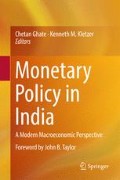Abstract
This volume presents research that applies contemporary monetary theory and state-of-the-art econometric methods to the analysis of the monetary and financial aspects of the Indian economy and the impact of monetary policy on economic performance. This chapter provides an overview of the individual chapters and discusses how they tie into the broader aims and scope of the volume.
Access this chapter
Tax calculation will be finalised at checkout
Purchases are for personal use only
Notes
- 1.
A full overview of fiscal dominance in India and of these reforms is provided by Reserve Bank of India (2013), “Report on Currency and Finance,” March 4, 2013. The narrative here draws from the Report.
- 2.
These points are made in the Chapter of this volume by Viral Acharya and Krishnamurthy Subramanian.
- 3.
See the Chapter of this volume by Atish Ghosh, Mahvash Qureshi and Eun Sung Jang.
- 4.
India’s recent experience with capital flow surges and stops is the subject of the Chapter of this volume by Poonam Gupta.
- 5.
Background for the inflation targeting framework adopted by the RBI is provided by Reserve Bank of India (2014), “Report of the Expert Committee to Revise and Strengthen the Monetary Policy Framework,” January 21, 2014.
- 6.
In India, there is open ended procurement of grains such as rice at the minimum support price (MSP). As a result, the wholesale market price cannot generally fall below the MSP. This policy also pre-empts the re-allocation of land and other resources from agriculture commodities to products that have support prices. Inflation is therefore fueled not only by demand pressures because of the mismatch between GDP growth and agricultural growth, but also the existing system of price support and procurement.
- 7.
Rajan (2015) argues that because of the RBIs past focus on WPI inflation, this put weight on internationally traded goods like commodities as opposed to domestic nontraded goods like services. This meant that whenever international inflation came down, pressure for a rate cut increased, leaving inadequate attention to domestic sources of inflation.
- 8.
Food price dynamics are very different in emerging market economies (EMEs) than in advanced economies (AEs). In EMEs food price shocks are more persistent and propagate strongly into nonfood inflation. Such second round effects are important in economies (such as India) where food is a high share in a household’s consumption basket. Therefore, for economies with important second round effects food inflation should not be ignored in the formulation of monetary policy.
References
Acharya, V. V. (2009). A theory of systemic risk and design of prudential bank regulation. Journal of Financial Stability, 5(3), 224–255.
Acharya, V. V., Engle, R., & Richardson, M. P. (2012). Capital shortfall: a new approach to ranking and regulating systemic risks. American Economic Review Papers and Proceedings, 102(3), 59–64.
Beck, T., Colciago, A., & Pfajfar, D. (2014). The role of financial intermediaries in monetary policy transmission. Journal of Economic Dynamics and Control, 43, 1–11.
Campbell, J. Y., & Shiller, R. J. (1991). Yield spreads and interest rate movements: a bird’s eye view. Review of Economic Studies, 58, 495–514.
Cogley, T., Primiceri, G. E., & Sargent, T. J. (2010). Inflation-Gap persistence in the US. American Economic Journal: Macroeconomics, 2(1), 43–69.
David, T., & Gurkaynak, R. (2015). Is optimal monetary policy always optimal? International Journal of Central Banking, 11(S1), 353–384.
Rajan, R. (2015). Strong sustainable growth for the Indian economy. Speech at FIBAC, Mumbai, August 24.
Rajan, R. (2014). Concerns about Competitive Monetary Easing, Policy Panel Discussion, Conference on Monetary Policy in a Post-Financial Crisis Era, Institute of Monetary and Economic Studies, Bank of Japan in Tokyo, May 28, 2014.
Reserve Bank of India (2013). Report on Currency and Finance. Mumbai: Reserve Bank of India (March).
Reserve Bank of India (2014). Report of the Expert Committee to Revise and Strengthen the Monetary Policy Framework. Mumbai: Reserve Bank of India (January).
Sargent, T. J., & Wallace, N. (1981). Some unpleasant monetarist arithmetic. Federal Reserve Bank of Minnesota, Quarterly Review, (Fall).
Stock, J. H., & Watson, M W. (2007). Has U.S. Inflation Become Harder to Forecast? In Proceedings—Economic Policy Symposium—Jackson Hole (vol. 39, pp. 3–33). Federal Reserve Bank of Kansas City.
Author information
Authors and Affiliations
Corresponding author
Editor information
Editors and Affiliations
Rights and permissions
Copyright information
© 2016 Springer India
About this chapter
Cite this chapter
Ghate, C., Kletzer, K.M. (2016). Introduction. In: Ghate, C., Kletzer, K. (eds) Monetary Policy in India. Springer, New Delhi. https://doi.org/10.1007/978-81-322-2840-0_1
Download citation
DOI: https://doi.org/10.1007/978-81-322-2840-0_1
Published:
Publisher Name: Springer, New Delhi
Print ISBN: 978-81-322-2838-7
Online ISBN: 978-81-322-2840-0
eBook Packages: Economics and FinanceEconomics and Finance (R0)

